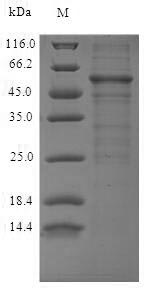Recombinant Human Protein Wnt-5a (WNT5A) is expressed in E. coli and comprises the full length of the mature protein, spanning amino acids 62 to 380. This product features an N-terminal 10xHis-SUMO-tag and a C-terminal myc-tag for ease of detection and purification. It exhibits a purity level greater than 90% as determined by SDS-PAGE, ensuring reliable performance for research applications.
Wnt-5a belongs to the Wnt family of proteins, which appear to be critical for various signaling pathways involved in developmental processes and cellular communication. This protein likely plays a significant role in non-canonical Wnt signaling, influencing cell movement and polarity. Studying it may prove vital for understanding complex cellular mechanisms and has far-reaching implications in developmental biology and disease research.
Potential Applications
Note: The applications listed below are based on what we know about this protein's biological functions, published research, and experience from experts in the field. However, we haven't fully tested all of these applications ourselves yet. We'd recommend running some preliminary tests first to make sure they work for your specific research goals.
The recombinant human WNT5A protein is expressed in E. coli with dual tags (N-terminal 10xHis-SUMO and C-terminal myc) and has unknown activity. WNT5A is a Wnt family protein that requires post-translational modifications, particularly palmitoylation, for correct folding, solubility, and biological activity. Since E. coli lacks the eukaryotic machinery for these modifications, the protein is likely to be misfolded, insoluble, or inactive. Therefore, this protein is probably not correctly folded or bioactive, and any applications requiring native structure or function should be approached with caution.
1. Antibody Development and Validation Studies
This recombinant WNT5A can be used as an immunogen for antibody generation, but antibodies produced may not recognize native, properly folded WNT5A due to potential misfolding from a lack of palmitoylation in E. coli. The dual tags provide epitopes for screening, but antibodies should be rigorously validated against mammalian-expressed, lipid-modified WNT5A to ensure recognition of physiological forms. The >90% purity is adequate for immunization, but tag-specific antibodies may dominate without careful screening.
2. Protein-Protein Interaction Studies
The tags facilitate pull-down or co-IP assays, but the misfolded protein may not engage in physiologically relevant interactions with receptors (e.g., Frizzled) or co-receptors. Any identified interactions should be considered artifactual until validated with properly modified WNT5A from mammalian systems. The dual tags allow flexible immobilization, but results may not reflect native binding due to incorrect folding.
3. Biochemical Characterization and Stability Studies
The protein can be used for basic biophysical studies (e.g., aggregation, thermal stability), but data may not translate to native WNT5A due to likely misfolding. Techniques like SEC or DLS may reveal aggregation or improper oligomerization unrelated to native behavior. Findings should be interpreted as artifacts of the expression system rather than true characteristics of functional WNT5A.
4. Tag-Based Purification Method Development
This application is less dependent on bioactivity, so the protein can be used to optimize purification protocols for tagged proteins. However, since misfolding may cause solubility issues, purification yields and tag accessibility might not represent ideal conditions for well-folded proteins. Method development should be validated with a properly folded protein to ensure generalizability.
Final Recommendation & Action Plan
This recombinant WNT5A from E. coli is unsuitable for applications requiring native structure or function due to likely misfolding from a lack of palmitoylation. Prioritize using it only for tag-based purification method development or as a negative control in antibody studies—avoid functional assays. If antibody development is attempted, immunize with this protein but screen hybrids against mammalian-expressed WNT5A to isolate antibodies that recognize native epitopes. For interaction studies, do not rely on results without validation with bioactive WNT5A.






